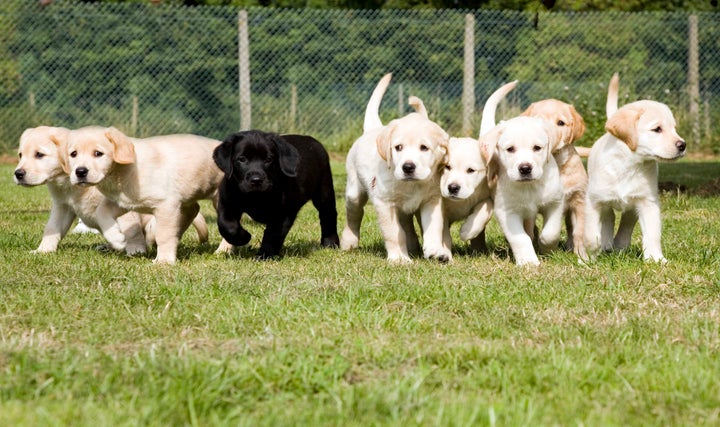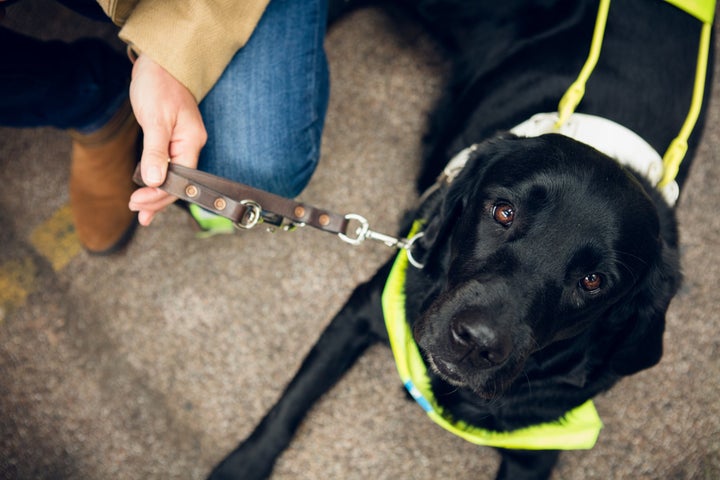‘Next Steps’ - a regular feature from our HumanKind project - focuses on how the public can take action to make a difference in society.
Paul King lost his sight back in 2018, going blind in the space of three days. Afterwards he became more and more withdrawn to the point where he was afraid to answer his own front door, let alone go outside. But when he got a guide dog, Oscar, everything changed.
“I had no idea just how priceless Oscar would become,” he wrote in a blog post on HuffPost UK. “He’s far more than a way for me to get around, he’s given me the confidence to speak to people again. I’ve always been a people person, and having Oscar brought me back to being me.”
There are 5,000 guide dogs across the UK who, on a daily basis, impact the lives of their owners dramatically. If you’re touched by Paul’s story and want to play a small part in helping other owners regain their confidence and independence, we spoke to Eleanor Stephens, engagement officer for Guide Dogs in Birmingham, about how to do just that.

Don’t stroke a guide dog
When you see a guide dog it can be hard to fight the urge to stroke their furry little heads - but Stephens warns you should absolutely resist.
“One of our key messages is don’t distract a working guide dog,” she says. You can tell a dog is working if it’s wearing a harness - at this point they are a mobility aid for their owner and so they need to be left alone.”
If you see a guide dog resting, Stephens says it’s still best to ask the owner before stroking that dog. “In some cases the dog might be tired or they might be working on obedience, so it’s always best to check,” she says.
Keep your pet(s) on a lead
Sadly, 12 guide dogs are attacked by pet dogs every month. These attacks can have devastating affects on the dogs, who may lose their confidence and become withdrawn, which in turn can impact their owners.
Mike Brace’s guide dog Izzy was attacked in London back in June 2016 and the pair are still dealing with the emotional scars from that day. “Izzy was badly hurt by a dog that sunk its teeth into her back – whilst the physical scars have healed she’s lost a part of herself, showing signs of anxiety, which breaks my heart,” Brace explains. “Each day a bit more of her sparkle returns but it all could have been avoided if the owner had put their dog on a lead that day.”
Stephens urges pet owners to put a lead on their dog if they see a guide dog approaching, even if they think their dog would be perfectly well behaved. It’s better to be safe than sorry.

Be aware of owners who might need help
If you’re out and about, and spot a guide dog owner who has dropped the handle of the harness (meaning it’s just resting on the dog’s back) this might be an indication to the general public that the person is looking for assistance.
If they’re on their own and haven’t moved for a while, it’s worth asking if everything is okay and offer your arm to guide them to where they need to be. “This can make a huge difference,” Stephens adds.
Don’t park on pavements
It might not be something you’ve even considered, but parking on pavements can seriously endanger guide dog owners - mainly because they have to veer around the car and potentially go into the road to pass.
“Be considerate, try and avoid pavement parking,” says Stephens. “It could have devastating effects for an individual.”
Don’t clutter the street
Whether it’s wheelie bins, A-boards outside cafés and pubs, or bin bags filled with waste, there are many obstacles cluttering pavements, which is bad news for guide dogs and their owners. So always be mindful of what you’re putting outside and where - make sure there’s plenty of room for people (and their four-legged friends) to get past.
Volunteer
People are also encouraged to offer their time to volunteer in various roles that can benefit both guide dogs and their owners. For example you can do puppy walking which involves looking after them in their first year, or boarding (which is basically where you look after the dogs and offer them a home while they’re in training). There’s also a service called My Guide where volunteers are trained in sighted guiding and they offer an hour or two each week or fortnight to help someone locally get out and about.
Donate or fundraise
It costs £56,000 to support a guide dog from birth to retirement and Guide Dogs are responsible for around 5,000 dogs across the UK. So that’s a lot of funding needed to keep things going. “We’re always keen for fundraisers to come forward,” says Stephens. “Whether it be through local fundraising groups, holding social events, naming a puppy - there are lots of different ways to get involved. Without volunteers and fundraisers we couldn’t do what we do.”
There’s also a sponsor a puppy scheme, where you donate £1 a week to follow a guide dog puppy’s journey through training.
Adopt
When guide dogs retire, or if they are withdrawn from training because they’re not quite the right fit, they inevitably need rehoming. Stephens says people are very welcome to get in touch about this, however there is a waiting list.